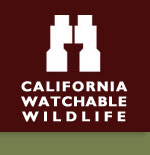

| Area: 793,000 Acres | ||
| Lat: 33.870012 | ||
| Lon: 115.75752 | ||
| Nearby Services | ||
| Site Facilities | ||
| Join Our Mailing List |
|
For Email Marketing you can trust
|
Top Banner Photo Credits
Pam Starr
Alyn Robert Brereton
Julie MacKinnon
Linda Pittman
Parham Pourahmad
Larry Whiting
Randall Finley
Pam Starr
Alyn Robert Brereton
Julie MacKinnon
Linda Pittman
Parham Pourahmad
Larry Whiting
Randall Finley
© 2008-2024 California Watchable Wildlife and Blue Cat Studio, Inc.
| Joshua Tree National Park - Site # 100 | |||
| Five California fan palm oases provide water, food and shade to resident house finches, ;hainopeplas, mourning doves, and Gambel's quail. | |||
 | Premium - the most significant sites, worth visiting if you have limited time. Premium sites have high wildlife values year-round, staff on site, interpretive programs and/or displays, and well-developed facilities. | ||
| Background: | Rugged 5,500-foot peaks give way to Mohave and Sonoran desert ecosystems, an arid landscape known for its dramatic Joshua trees. The tree's dagger-like leaves and cream-colored blossoms are a magnet for cactus wrens, ladder-backed woodpeckers, and Scott's orioles. Yucca night lizards, ground squirrels, and wood rats are usually nearby. Five California fan palm oases provide water, food and shade to resident house finches, ;hainopeplas, mourning doves, and Gambel's quail. Western pipistrelles and other bats pass the day among the fronds, day and night, desert cottontails, coyotes, kit foxes, bobcats, and desert bighorn sheep make secretive trips to the water. The lower desert's creosote bush and cacti shelter black-throated sparrows, desert iguanas, and kangaroo rats, a half-dozen rattlesnake species make this desert their home. Be sure to stop at the Twentynine Palms Visitor Center. | ||
| The Experience: | Three desert ecosytems connect within the park | ||
| Wildlife and Where to Find It: | Car, hiking and overlooks | ||
| Viewing Tips: | More than 230 bird species, many mammals, reptiles. High probability of seeing songbirds in spring and fall, reptiles from spring through fall. Birds of prey are seen year-round. Low probability of seeing small mammals, predators, and bighorn sheep, but all are present year-round. Watch for wildlife near oases and water, during mornings and evenings. Three visitor centers. Horse trails, driving tour. HOT SUMMERS. WINDING, NARROW ROADS. | ||
| Festivals & Events: | | ||
| Visitor Information: | California Welcome Center, Yucca Valley - (760) 365-5464 - http://www.visitcwc.com/destinations/yuccavalley/index.php | ||
| Viewing Site Hours of Operation are: | |||
| Staff On-site: | Yes | ||
| Open: | Everday | ||
| Hours: | 24 hours | ||
| Year Round: | Yes | ||
| Road Information: | |||
| Roads available year-round. | |||
| Road Hazards: Flash floods | |||
| Parking Fee: | |||
| Proximity to viewing area: | |||
| Parking Notes: | |||
| How to Get There: | Main entrance, From Interstate 10,take Highway 62 to Joshua Tree or Twentynine Palms. In town of Joshua Tree, turn south on Park Boulevard to visitor center, in Twentynine Palms, turn south on Utah Trail to visitor center. Or use south entrance off Interstate 10, 26 miles east of Indio. | ||
| Contact Information | |||
| Managing Agency: | National Park Service | ||
| Agency Site URL: | http://www.nps.gov/jotr | ||
| Physical Address: | 74485 National Park Drive Twentynine Palms, CA 92277 |
Agency 2: | 74485 National Park Drive Twentynine Palms, CA 92277 |
| Manager Phone: | (760) 367-5500 | Contact Us: | by Email |
| Site Phone: | (760) 367-7500 | ||
| County: | |||
| Addition Website: | |||
